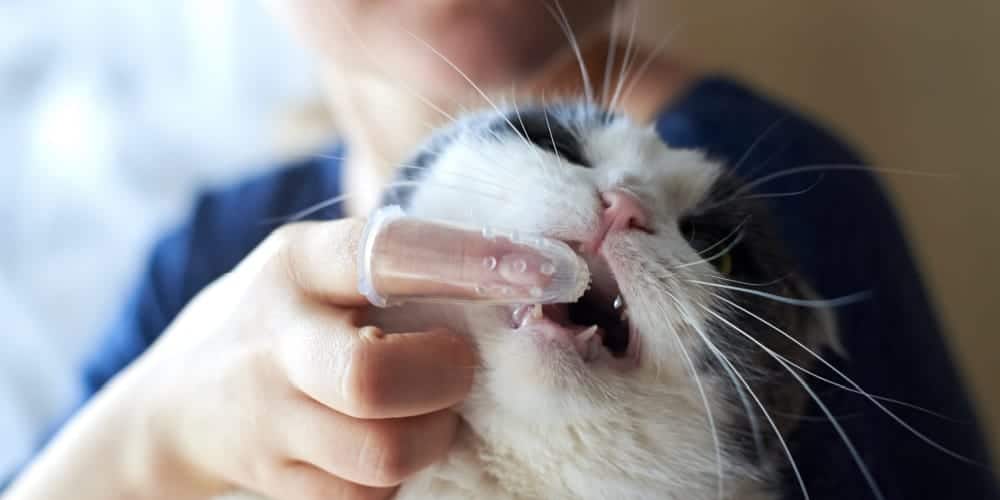How to Brush Your Cat’s Teeth

Just like humans, brushing the cat’s teeth is the most efficient way to get rid of plaque and tartar buildup and keep his teeth in perfect condition. However, some people aren’t aware of the importance of brushing their cat’s teeth regularly. And this is why more than half of the cats above the age of four end up with painful inflammation in the tissues surrounding the teeth as well as other dental problems.
You can learn how to brush your cat’s teeth after every meal to maintain proper oral health. This can protect your cat from lots of painful and annoying symptoms in the long run. See below how you can learn the best way to protect your cat’s teeth.
Cat Attitudes is reader-supported. When you buy through links on our site, we may earn an affiliate commission.
Why Should You Brush Your Cat’s Teeth?
When cats eat, the food leftovers accumulate around the teeth leading to the formation of plaque. Plaque causes periodontal disease or the painful inflammation of the gums. After a while, the plaque mineralizes and turns to tartar which infects the gums and eventually leads to teeth loss.
The saliva in the mouth reacts with the food residue to create chemical compounds that later cover the teeth and the gums. The bacteria in the mouth should also be removed before it affects the roots of the teeth.
Regular brushing is a powerful way of eliminating the risk of teeth loss as well as the painful inflammation of the gums. It also guarantees that your cat won’t have bad breath.
Having your cat’s teeth checked by a vet is essential, and at some point, your feline might still need some professional dental cleaning. However, brushing his teeth at home will help keep his teeth in perfect condition for a longer period.
When Should You Start Brushing Your Cat’s Teeth?
Things can become easier with your cat when you can establish a routine. The best time to start brushing your cat’s teeth is when he’s still a kitten. The younger your cat is, the easier it is to get accustomed to a new routine.
The best way to get your cat used to having his teeth brushed is to brush his teeth every day. If you can’t establish a daily routine, you should try to brush your cat’s teeth at least three to four times a week to get rid of the plaque buildup and the germs that accumulate around the teeth.
If you have an older cat, the process might take a little longer because your kitty won’t be accustomed to having its teeth brushed and its mouth held wide open. Even if you have a younger kitten, it might still be uncomfortable with the idea of having his teeth brushed. Patience and regular training will be the key to success.
Before You Brush Your Cat’s Teeth
Using the right tools and following the adequate steps are necessary for good dental care. Whether you’re brushing your kitten’s teeth for the first time or are trying to brush the teeth of an older cat, you might need to have the first session of dental care at the vet’s. The vet will be able to comfort or even sedate the cat if it’s not feeling comfortable.
After the first professional dental care session, it will be a good idea to let the cat heal for a few days as the gums might be irritated. This is crucial, especially if your cat had an inflamed gum or had any teeth removed. When you feel that the cat is comfortable enough, it will be time to establish a daily dental care routine at home.
Adding some dry food to your cat’s diet is a good step to help reduce the plaque and tartar buildup to keep the teeth healthy. There are also cat dental chews, gels, and mouthwashes that can help make dental care more efficient and easier.
What Do You Need to Brush Your Cat’s Teeth?
It’s essential to follow the right techniques and use the proper equipment to brush your cat’s teeth. This will help it get used to the home dental care routine and will also make your job easier. You will need the following tools.
- A special toothbrush that has been designed for cats or pets. Some pet toothbrushes are finger toothbrushes that you can attach to your finger rather than hold from the handle. These toothbrushes are easier to control.
- Cat toothpaste. This toothpaste is different from the one designed for humans because the one designed for humans might cause gastric problems. There are different flavors of cat toothpaste, and you should experiment until you find one that your kitty really likes. Most cats prefer chicken, beef, or seafood flavors because they resemble the flavor of meals that they prefer.
- A cotton bud or Q-tip to help during the training process. This will get the cat used to the process of having its teeth brushed regularly.
With the right tools, you’ll be able to do the job successfully by following these steps.
- Get your cat used to the taste and texture of the toothpaste. This will make the toothbrushing process easier. Put a small amount of the toothpaste on your finger, and hold it close to the cat’s nose to get it used to the odor. If your cat seems reluctant, then you might need to switch to a different flavor.
- When your cat has gotten used to the smell of the toothpaste, you should put a small amount on your finger and offer it to your cat. Some cats will immediately love the taste, while others might take more time to get used to it.
- During the first two days, you should try to find a comfortable position that allows you to hold the cat’s head, so you can brush its teeth properly without making it uncomfortable. It’s recommended to try this when the cat is a bit sleepy, so it’s less resistant. When your cat is comfortable, you can try approaching it at different times throughout the day, so it doesn’t feel startled when it’s finally time to have its teeth brushed.
- Approach your cat from the back and hold its head comfortably, as approaching the cat from the front can be too aggressive. Even if it wriggles, it will move towards you so you can have a better grip.
- Have a gentle yet firm grip to hold your cat’s head without pressing too hard. Put the palm of your hand on the top of the cat’s head and use your thumb and index finger to press the cheekbone while making sure that you’re not covering your cat’s eyes to keep it comfortable.
- Tilt his head gently to the back and use your thumb to lift the upper lip to expose the teeth. Use the fingers of the other hand to pull the bottom lip to have a better view of your cat’s teeth. If your cat seems uncomfortable, you might need to give it a break, pet him on the head for a while, and then try again.
- In some cases, cats can be a little reluctant to the whole idea of being touched and handled. In this case, you might have to wrap your cat in a towel or blanket to calm it down and keep it warm. It might be a good idea to ask someone else to hold the cat’s feet to keep it stable.
- After a couple of days, repeat the same process but apply some toothpaste on a cotton bud or Q-tip. Use it to rub the cat’s teeth in a circular motion. While this will not remove the plaque or food residue, it’s an essential part of the cat’s training.
- Start at the back teeth because these are usually the most challenging to clean. At the same time, this is where most of the food will build up to cause infection. Work your way to the front until you reach the canines.
- Keep on repeating the previous steps for several days until your cat is no longer reluctant to have its teeth touched or cleaned.
- When your fur baby is comfortable, start using the toothbrush. Use the toothbrush in a circular motion and start by brushing each side of the teeth for 10 seconds at a time. Increase the duration gradually until you’re able to brush the teeth for 30 to 45 seconds at a time.
You might notice some signs of bleeding. This is quite normal, especially if you have an older cat. After regular tooth brushing sessions, the bleeding will stop.
If you feel that you can’t master the technique of proper dental care at home, you can ask the vet for help. Vets can demonstrate the appropriate way to hold the cat and introduce tooth brushing without much resistance.
The timeline can be different for every cat, as some are more sensitive than others. You should give your kitty all the time it needs so that dental care becomes a pleasant experience that doesn’t trigger any feelings of anxiety or stress.
Final Thoughts
Taking care of your cat’s teeth is part of your responsibility as a loving pet owner. Although most cats don’t like to be touched and will likely resist having their teeth brushed, establishing a regular dental care routine is a must.
Give your cat time and start by getting it accustomed to the odor and flavor of the cat toothpaste. Use your fingers, then switch to a special toothbrush to remove all the plaque and tartar buildup to protect your cat’s teeth. If you find it impossible to brush your cat’s teeth, make sure it gets done by the vet as part of your cat’s comprehensive medical care.
